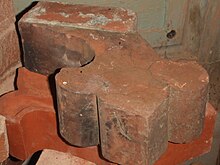Shaped stone

A shaped stone is a brick that, deviating from the usual cuboid shape, has been manufactured in a special shape in order to fulfill a special function, for example as a ridge stone or for a masonry arch.
Description and areas of application
Shaped stones were often used in the brick Gothic. They stand out due to a rich variety of shapes, including turned bricks, which, for example, decorate the house entrance areas in Reitende Diener-Straße in Lüneburg . Also Tausteine came in the late Gothic and Renaissance to the facade design to application. These stones were shaped like twisted ropes ( ropes ). Lined up next to one another, the builders used them primarily for window or door frames or used them to create borders for medallions or friezes .
In the masonry construction of the early 19th century, numerous shaped stones were used, which depicted, modified or combined suitable elements of different historical styles. All shaped stones were recorded in the catalog to enable them to be adapted to new building tasks.
The hand mark on the brick that had been visible for centuries was replaced by a machine molding process from the end of the 19th century. The effect of the smooth surfaces of pressed stones could be enhanced by different colored glazes .
Despite the similarity of the name, Formstein should not be confused with American Formstone , which is a process for cladding facades with artificial stone .
literature
- Antje Seidel: The brick city of Lüneburg - building culture through the centuries , presentation of the special baking-form stones used in Lüneburg ( Christmas brochure ). Published by the Federal Association of the German Brick and Tile Industry e. V., Bonn, 2014.
Web links
- Examples of current shaped stones - from the product range of a manufacturer

